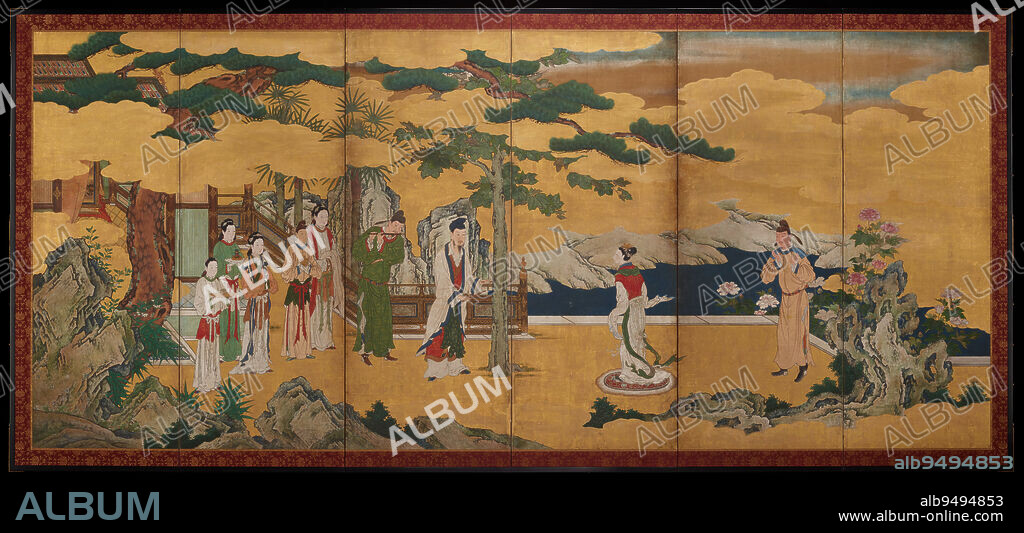alb9494853
Emperor Ming Huang and Yang Guifei, around 1600, attributed to Kano Naganobu, Japanese, 1577 - 1654, 61 1/2 × 140 1/2 in. (156.21 × 356.87 cm) (image), Ink, color, and gold leaf on paper, 16th-17th century, The poem Song of Everlasting Sorrow (Changhen ge), by Chinese poet Bai Juyis (772846), tells the story of Emperor Xuanzong (685762; reigned as Emperor Minghuang) and his breathtakingly beautiful favorite concubine Yang Guifei (719756). This painting shows Guifei dancing at right in front of the emperor and several attendants. A rebellion in 755 forced the emperor to flee the capital, and angry imperial guardsbelieving that Yang Guifei was responsible for Xuanzongs neglect of state affairsdemanded her execution and put her to death. Xuanzong abdicated the throne shortly thereafter, triggering the decline of the dynasty. This tragic love affair became a popular subject among Kano painters like Kano Naganobu (15771654), who moved his branch of the Kano House to the capital, Edo (present-day Tokyo), in 1605 and became the first Kano painter to serve as painter-in-attendance to the Tokugawa shoguns.

|
Add to another lightbox |
|
Add to another lightbox |



Buy this image.
Select the use:

Caption:
Emperor Ming Huang and Yang Guifei, around 1600, attributed to Kano Naganobu, Japanese, 1577 - 1654, 61 1/2 × 140 1/2 in. (156.21 × 356.87 cm) (image), Ink, color, and gold leaf on paper, 16th-17th century, The poem Song of Everlasting Sorrow (Changhen ge), by Chinese poet Bai Juyis (772846), tells the story of Emperor Xuanzong (685762; reigned as Emperor Minghuang) and his breathtakingly beautiful favorite concubine Yang Guifei (719756). This painting shows Guifei dancing at right in front of the emperor and several attendants. A rebellion in 755 forced the emperor to flee the capital, and angry imperial guardsbelieving that Yang Guifei was responsible for Xuanzongs neglect of state affairsdemanded her execution and put her to death. Xuanzong abdicated the throne shortly thereafter, triggering the decline of the dynasty. This tragic love affair became a popular subject among Kano painters like Kano Naganobu (15771654), who moved his branch of the Kano House to the capital, Edo (present-day Tokyo), in 1605 and became the first Kano painter to serve as painter-in-attendance to the Tokugawa shoguns.
Credit:
Album / quintlox
Releases:
Model: No - Property: No
Rights questions?
Rights questions?
Image size:
8205 x 3843 px | 90.2 MB
Print size:
69.5 x 32.5 cm | 27.4 x 12.8 in (300 dpi)
Keywords:
1577-1654 • 15771654 • 1600 • 1605 • 16TH-17TH CENTURY • 685762 • 719756 • 755 FORCED • 772846 • ANGRY IMPERIAL GUARDSBELIEVING • ATTRIBUTED • BRANCH (TREE) • BRANCH • BRANCHES • BREATHTAKINGLY BEAUTIFUL FAVORITE CONCUBINE YANG GUIFEI • CAPITAL • CHANGHEN GE • CHINESE POET BAI JUYI'S • COLOR • COLOUR • DEATH • DECLINE • DYNASTY • EDO • EMPEROR MING HUANG • EMPEROR MINGHUANG • EMPEROR XUANZONG • EMPEROR • EVERLASTING SORROW • EXECUTION • FIRST KANO PAINTER • FLEE • FRONT • FRONTAL • GOLD LEAF • GOLDFOIL • GUIFEI DANCING • IMAGE • INK • JAPANESE • KAISER • KANO HOUSE • KANO NAGANOBU • KANO PAINTERS • MOVED • PAINT • PAINTER-IN-ATTENDANCE • PAINTING • PAINTINGS • PAPER AND PACKAGE PRODUCTS • PAPER • POEM SONG • POPULAR SUBJECT • PRESENT-DAY TOKYO • RAMA • REBELLION • REIGNED • RESPONSIBLE • RIGHT • RUN AWAY • SERVE • SEVERAL ATTENDANTS • SHORT STORY • STATE AFFAIRSDEMANDED • STORY • TELLS • THRONE SHORTLY THEREAFTER • TOKUGAWA SHOGUNS • TORMENTER • TRAGIC LOVE AFFAIR • TREE BRANCHES • TRIGGERING • XUANZONG ABDICATED • XUANZONG'S NEGLECT • YANG GUIFEI
 Pinterest
Pinterest Twitter
Twitter Facebook
Facebook Copy link
Copy link Email
Email
